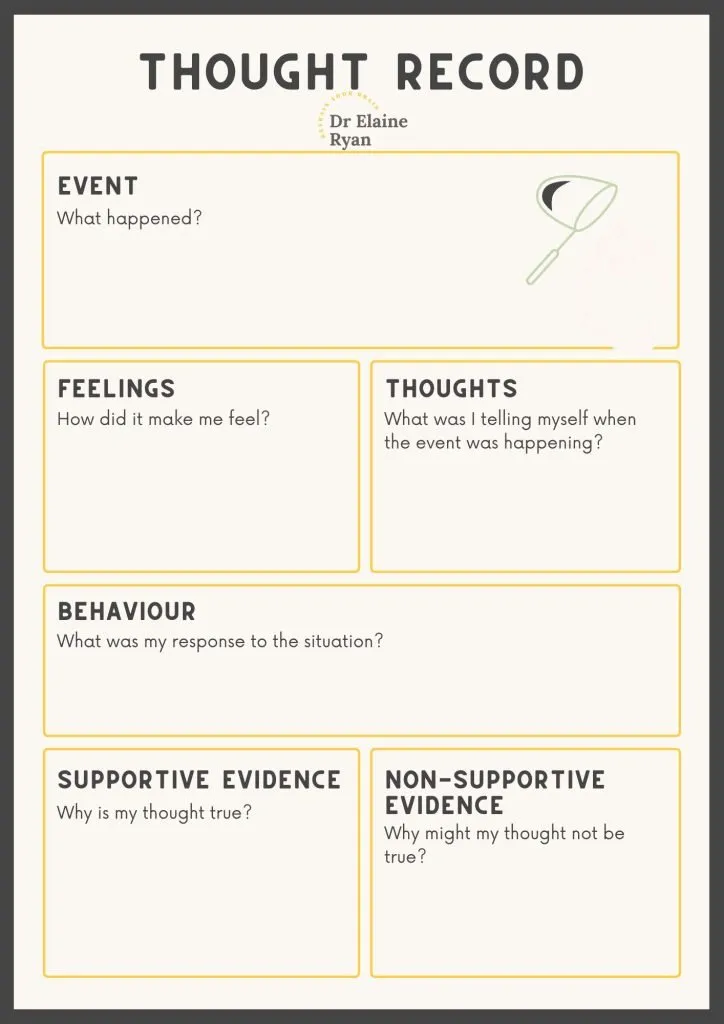If you have been having problems with anger, your GP may have referred you for Cognitive Behavioural Therapy (CBT). In this article, I will explain what CBT is, how it works, and where to get it.
Cognitive-behavioral therapy (CBT) is a very practical talking therapy for dealing with anger and research has shown it is effective in helping people with their anger. It focuses on the interconnection between thoughts, feelings, and behaviours. Changing one has a direct impact on the other two, and I’ll give a quick example now before continuing.
Bláthnaid gets snappy at work because she feels really angry when she thinks the people she works with do not respect what she has to say in departmental meetings. Specifically, she thinks they completely ignore everything I say.
Using basic CBT, if she reframes the thought, I have no evidence to prove I was ignored; in previous meetings, they have implemented my ideas, and today, they could have been too caught up in their own ideas or problems.
This one change in thinking can impact feelings and behaviours. Bláthnaid is less likely to feel angry and storm off.
Retrain Your Brain® Anger Management

Dr Ryan’s online self-help course for anger
Understanding Anger and Its Impacts
Anger is a universal emotion experienced by everyone. It is a natural response to perceived threats, injustices, or frustrations. I won’t go into detail explaining anger as I have fully covered the emotion in this article. Instead, this article will focus on explaining the model of therapy that can help you if your anger is affecting other areas of your life.
Problematic anger can affect your relationships and work and even get you into trouble with the law, but it also affects your health, increasing the risk of cardiovascular diseases, high blood pressure, and other health issues.
On a psychological level, uncontrolled anger can contribute to mental health disorders such as depression, anxiety, and substance abuse. It can also lead to feelings of guilt, regret, and low self-esteem, further exacerbating emotional distress.
So, if you have made the decision to get help with your anger, that’s great, and CBT is a good place to start, as you can try this at home before seeking professional help if needs be.
How does it work?
CBT offers a range of practical techniques for managing anger. These techniques fall into three main categories: cognitive, behavioural, and physiological. Each category targets a different aspect of anger, addressing the thoughts, behaviours, and physical reactions associated with this emotion.
Cognitive techniques focus on the mind. They involve changing the way you think about and interpret situations that trigger anger as was shown in the example above with Bláthnaid. Behavioural techniques, on the other hand, target your actions. Aiming to modify the way you respond to things that make you angry, for example, rather than shout or get physical CBT will teach you different ways to express your anger or use relaxation techniques to help calm you down, as once calm, you won’t feel the need to lash out.
Physiological techniques address the physical symptoms of anger. These techniques help manage the bodily reactions that accompany anger, such as increased heart rate or muscle tension. By learning to control these physical responses, you can reduce the intensity of your anger and prevent it from going any further.
I shall go through these one at a time now.
Cognitive Techniques
Cognitive techniques are at the heart of CBT and they involve first of all being able to identify a troublesome thought, like Bláthnaid’s thought of everyone not listening to her, and then challenging it. Another cognitive technique is the use of anger logs or journals. These tools help individuals track their anger episodes, identify triggers, and monitor progress. The goal is to replace these unhelpful thoughts with more balanced and rational ones and you generally record these thoughts on a CBT worksheet like the one in the image below.

Identifying Triggers and Patterns of Anger
A crucial step in managing anger using CBT is identifying what triggers it. Triggers can be external, such as a specific person or situation, or internal, like a thought or memory. By recognizing these triggers,you can then anticipate and prepare for situations that could possibly cause you anger. CBT gives you a plan, rather than being left at the mercy of your emotions, you can prepare and practice different responses.
And speaking of being left at the mercy of your anger, you will learn to recognise anger as it starts to emerge, this gives you a chance to calm the emotion.
Behavioural Techniques
Behavioural techniques in CBT for anger include assertiveness training and problem-solving skills. Assertiveness training is really just to help you express anger in a healthy, constructive way, rather than resorting to aggression. For many people and you might be one of them, they are not aware than you can express anger, indeed it is healthy and acceptable to do so, you just need to do it in a certain way.
Physiological Techniques
Physiological techniques help you calm the physical aspects of anger, giving you control over the emotion. Relaxation strategies, such as deep breathing and progressive muscle relaxation, are commonly used.
Finding Professional Help
If you are having difficulty managing your anger on your own, you can meet with a therapist who is experienced in working with anger. A CBT therapist can help. I also use the skills training aspect of Dialectical Behavioural Therapy (DBT) to help with anger, but a CBT therapist on their own is a good choice.If you are having difficulty in finding a therapist, reach out to your local GP as they will be able to recommend someone in your area.
If you meet with a professional I shall outline what sessions will be like. We devise what is called a treatment plan and you can see this below.
Week 1: Initial Assessment and Goal Setting
- Objective: Understand the client’s history, triggers, and the impact of anger on their life.
- Activities:
- Conduct a thorough assessment (interviews, questionnaires like the Anger Disorders Scale).
- Identify specific anger triggers and situations.
- Set SMART goals (Specific, Measurable, Achievable, Relevant, Time-bound) for therapy.
Week 2: Psychoeducation
- Objective: Educate the client about anger and its effects.
- Activities:
- Explain the anger cycle (trigger, thoughts, feelings, behaviour, consequences).
- Discuss the physiological, emotional, and cognitive aspects of anger.
- Introduce the concept of CBT and how it applies to anger management.
Week 3: Identifying Anger Triggers
- Objective: Help the client identify specific situations and thoughts that trigger anger.
- Activities:
- Use an anger diary to track incidents of anger.
- Analyze patterns and common triggers.
- Discuss and document these triggers.
Week 4: Cognitive Restructuring (Part 1)
- Objective: Challenge and change unhelpful thoughts related to anger.
- Activities:
- Introduce cognitive distortions (e.g., all-or-nothing thinking, overgeneralization).
- Teach techniques for identifying and challenging these distortions.
- Practice through role-playing or real-life examples.
Week 5: Cognitive Restructuring (Part 2)
- Objective: Continue practicing cognitive restructuring techniques.
- Activities:
- Further practice identifying and challenging unhelpful thoughts.
- Use thought records to document and reframe thoughts.
- Encourage daily practice and provide feedback.
Week 6: Relaxation Techniques
- Objective: Teach the client relaxation techniques to manage physiological arousal.
- Activities:
- Introduce deep breathing exercises.
- Teach progressive muscle relaxation.
- Practice guided imagery or mindfulness meditation.
Week 7: Problem-Solving Skills
- Objective: Develop effective problem-solving skills to handle anger-provoking situations.
- Activities:
- Introduce a step-by-step problem-solving model (identify the problem, brainstorm solutions, evaluate options, implement a solution, review the outcome).
- Practice problem-solving with real or hypothetical situations.
Week 8: Assertiveness Training
- Objective: Teach the client assertive communication skills.
- Activities:
- Discuss the differences between passive, aggressive, and assertive communication.
- Role-play assertive communication techniques (e.g., using “I” statements).
- Practice in real-life situations and provide feedback.
Week 9: Exposure and Behavioral Experiments
- Objective: Gradually expose the client to anger-provoking situations to practice new skills.
- Activities:
- Develop a hierarchy of anger-provoking situations.
- Gradually expose the client to these situations in a controlled manner.
- Conduct behavioural experiments to test new coping strategies.
Week 10: Review and Reinforcement
- Objective: Reinforce and review the skills learned so far.
- Activities:
- Review progress towards goals.
- Reinforce the use of cognitive and behavioural techniques.
- Identify any remaining challenges and address them.
Week 11: Relapse Prevention
- Objective: Prepare the client for potential setbacks and develop a maintenance plan.
- Activities:
- Discuss common triggers for relapse.
- Develop a plan for dealing with setbacks.
- Encourage ongoing practice of skills.
Week 12: Termination and Future Planning
- Objective: Conclude therapy and plan for the future.
- Activities:
- Review progress and achievements.
- Discuss the client’s plan for maintaining gains.
- Schedule follow-up sessions if necessary.
I hope that this information has been useful and just a few final words. You can learn how to manage your anger, not just for other people or maybe you got a court order, but do it for yourself as well, as it will make a huge difference in your life.
